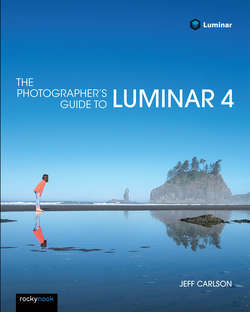Читать книгу The Photographer's Guide to Luminar 4 - Jeff Carlson - Страница 34
На сайте Литреса книга снята с продажи.
Copy File Options
ОглавлениеWhen you choose Edit a Copy with Lightroom Adjustments, you can choose which file format is used for the copy that gets edited. For the most part, the default settings will work fine, but it’s good to know what’s happening in transit between the two applications. Click the Copy File Options exposure triangle to reveal the following settings:
•File Format: The default format is TIFF, which retains the same image quality as the version you’re sending. TIFF is a lossless format, which means no data is thrown away to reduce the size of the file (though you can impose compression further down). Although you can choose JPEG as an option, I don’t recommend it because you’re discarding valuable image data before you’ve even started editing. PSD (Photoshop native format) is also available.
•Color Space: In digital imaging, color space refers to the total number of colors that can be stored and displayed. Color spaces have changed over the years as cameras and monitors have improved. This sounds like an ever-advancing leap into the future, but it can also trip up older systems that can’t show all the colors in the file. As with shooting in raw or capturing more megapixels with a newer camera, it’s good to work with more data than less. Lightroom’s native color space is ProPhoto RGB, so that’s what I recommend using. The dialog often defaults to Adobe RGB (1998), so it’s worth checking the Copy File Options and switching to ProPhoto RGB before clicking the Edit button.It’s worth noting that photo editing is best done using color-calibrated equipment. Both macOS (in the Displays preference panel) and Windows (in the Display Color Calibration control panel) include tools for calibrating your screen to show accurate color. Other companies sell more advanced calibration gear.
•Bit Depth: Leave this option set to 16 bits/component to ensure the most color information is included in the file for editing.
•Resolution: I suggest leaving this field set to the default; increasing or reducing the resolution is better done when exporting the image for use elsewhere. Our main concern is maintaining fidelity with the original when editing in Luminar.
•Compression: Keep this option set to None. Choosing ZIP requires your computer to work harder to decompress the file. If you’re tight on disk space, I recommend buying a larger hard drive.
One important thing to keep in mind is that editing a Lightroom Classic image using Luminar’s plug-in mode is a one-way trip. After you’ve clicked Apply and sent the adjusted image back to Lightroom, the edits are burned into that version; you can’t go back to Luminar and change any of the settings you made. Even if you specify the original file to be edited when sending the edited TIFF back to Luminar, all the editing controls are reset back to their defaults. You can build on top of what you’ve already done, but you can’t, say, change the Shadows amount from +50 to +25.
